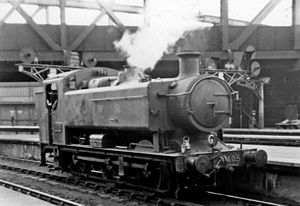This article includes a list of general references, but it lacks sufficient corresponding inline citations. (December 2014) |
The Great Western Railway (GWR) 9400 Class is a class of 0-6-0 pannier tank steam locomotive, used for shunting and banking duties.
| Great Western Railway 9400 class | |||||||||||||||||||||||||||||||||||||||||||||||||||
|---|---|---|---|---|---|---|---|---|---|---|---|---|---|---|---|---|---|---|---|---|---|---|---|---|---|---|---|---|---|---|---|---|---|---|---|---|---|---|---|---|---|---|---|---|---|---|---|---|---|---|---|
 9405 at Paddington in 1947 | |||||||||||||||||||||||||||||||||||||||||||||||||||
| |||||||||||||||||||||||||||||||||||||||||||||||||||
| |||||||||||||||||||||||||||||||||||||||||||||||||||
| |||||||||||||||||||||||||||||||||||||||||||||||||||
| |||||||||||||||||||||||||||||||||||||||||||||||||||
The first ten 9400s were the last steam engines built by the GWR. After nationalisation in 1948, another 200 were built by private contractors for British Railways (BR). Most had very short working lives as the duties for which they were designed disappeared through changes in working practices or were taken over by diesel locomotives. Two locomotives survived into preservation, with the oldest of the class, 9400 as part of the National Collection.
Design
editThe 9400 class was the final development in a long lineage of tank locomotives that can be directly traced to the 645 Class of 1872. Over the decades details altered, the most significant being the adoption of Belpaire fireboxes necessitating pannier tanks.
The 9400 resembled a pannier tank version of the 2251 class, and indeed shared the same boiler and cylinders as the 2251, but was in fact a taper-boilered development of the 8750 subgroup of the 5700 class. The advantage was a useful increase in boiler power, but there was a significant weight penalty that restricted route availability. The 10 GWR-built locomotives had superheaters but the remainder did not.
The 9400s were numbered 9400–9499, 8400–8499 and 3400–3409. BR gave them the power classification 4F.
Build details
edit| Lot No. | Fleet Nos. | Manufacturer | Serial Nos. | Date | Notes |
|---|---|---|---|---|---|
| 365 | 9400–9409 | Swindon Works | — | 1947 | |
| 382 | 9410–9459 | Robert Stephenson and Hawthorns | 7547–7596 | 1950–1951 | |
| 383 | 9460–9489 | Robert Stephenson and Hawthorns | 7611–7640 | 1950–1953 | |
| 384 | 8400–8449 | W. G. Bagnall | 2910–2959 | 1949–1954 | |
| 385 | 8450–8479 | Yorkshire Engine Company | 2443–65/67–71/66/72 | 1949–1952 | |
| 386 | 8480–8499 | Robert Stephenson and Hawthorns | 7450–7469 | 1952 | under subcontract from Hudswell Clarke |
| 387 | 9490–9499 | Yorkshire Engine Company | 2544–2553 | 1954–1955 | under subcontract from Hunslet Engine Company |
| 387 | 3400–3409 | Yorkshire Engine Company | 2575–2584 | 1955–1956 | under subcontract from Hunslet Engine Company |
No. 3409 was the last locomotive built for British mainline use by private contractors, as well as the last steam locomotive built for British Railways to a pre-nationalisation design. It was ordered by GWR in December 1947 and delivered by Yorkshire Engine Company in October 1956.[3]
Operations
editThe 9400 Class migrated to most parts of the former GWR, with many based in South Wales and at Old Oak Common. Here they were used on Paddington empty stock work until the end of steam on the Western Region in 1965. A common sight on the departure side in 1964–1965 was a worn down 9400 Class locomotive without number plates waiting with a line of Mark 1 coaches.[citation needed]
Numbers 8400 to 8406 served as bank engines on the Lickey Incline after its transferral to the Western Region.
Preservation
editTwo have been preserved:
| GWR/BR No. | TOPS No. | Home base | Notes | Image |
|---|---|---|---|---|
| 9400 | n/a | Swindon Steam Railway Museum | Part of the National Railway Collection | |
| 9466 | 98466 | West Somerset Railway | The locomotive is operational and mainline certified. Frequent visitor to the Mid-Norfolk Railway, the Metropolitan Line and other lines running charters, including a special funeral train for its owner. Formerly based at the Buckinghamshire Railway Centre privately owned by Dennis B Howells until his death in 2018,[4] the locomotive was subsequently sold to JJP Holdings South West Ltd and was based at the West Somerset Railway after a short return visit to the Mid-Norfolk Railway.[5] It was resident at the Ecclesbourne Valley Railway where it was to remain until its boiler ticket expires at the end of 2025.[6][7] It has since moved back to the West Somerset Railway in early 2022 following analysis of weight restrictions on the line which concluded that the locomotive was safe to operate on the line once again. It will operate on the West Somerset Railway until its boiler ticket expires in 2025.[8] |
See also
edit- GWR 0-6-0PT – list of classes of GWR 0-6-0 pannier tank, including table of preserved locomotives
References
edit- ^ Champ, Jim (2018). An Introduction to Great Western Locomotive Development. Barnsley: Pen & Sword Transport. p. 320. ISBN 978-1-4738-7784-9. OCLC 1029234106. OL 26953051M.
- ^ Whitehurst 1973, pp. 32, 70, 73–74.
- ^ Atkins 1999, p. 51.
- ^ "Home". 9466 Locomotive Group. Retrieved 26 June 2019.
- ^ "(home)". Mid-Norfolk Railway. Retrieved 26 June 2019.
- ^ "Virtual Engine Shed". Ecclesbourne Valley Railway. Retrieved 26 May 2021.
- ^ "Steam Locomotive 9466 set for Ecclesbourne stay until 2025". Rail Advent. Retrieved 26 May 2021.
- ^ "Pannier steam locomotive to see out boiler ticket in Somerset". Rail Advent. Retrieved 23 February 2022.
Sources
edit- Atkins, Philips (1999). The Golden Age of Steam Locomotive Building. Penryn, Cornwall: Atlantic Transport Publishers and the National Railway Museum. ISBN 0-906899-87-7. OCLC 468585665.
- Russell, J.H. (1975). A Pictorial Record of Great Western Engines.
- Whitehurst, Brian (1973). Great Western Engines, Names, Numbers, Types and Classes (1940 to Preservation). Oxford, UK: Oxford Publishing Company. pp. 32, 70, 73–74, 82, 102, 158. ISBN 978-0-9028-8821-0. OCLC 815661.
Further reading
edit- Derry, Richard (2008). The Pannier Papers No.1 94XX 84XX 34XX. The Irwell Press.